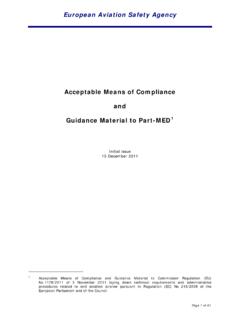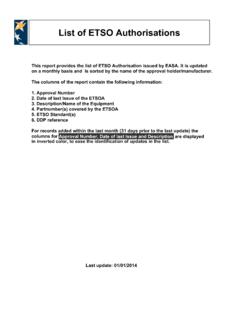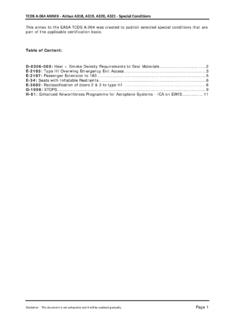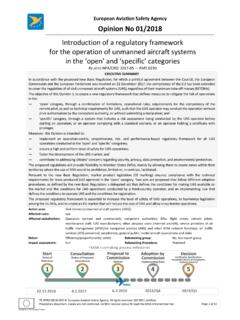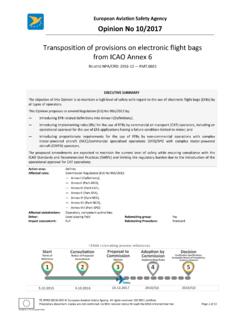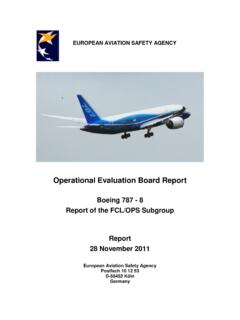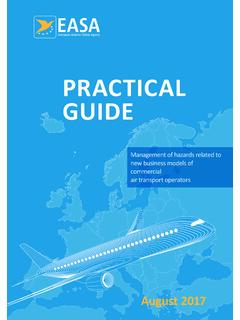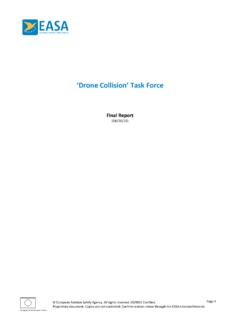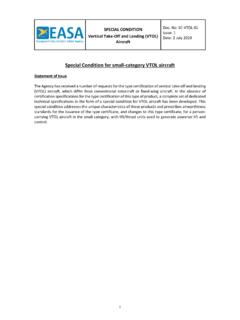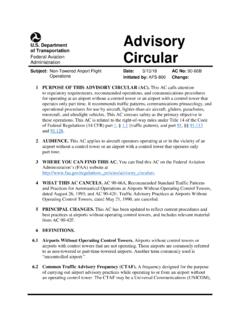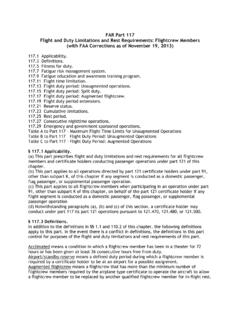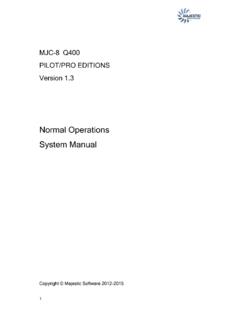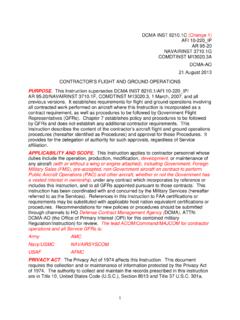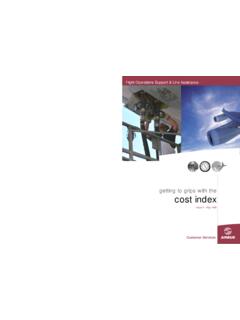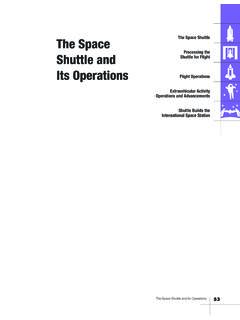Transcription of Flight Test Operations Manual Guide
1 Flight Test Operations Manual Guide Initial Issue, Apr 2018 Certification Department European Aviation Safety Agency. All rights reserved. ISO9001 Certified. Proprietary document. Copies are not controlled. Confirm revision status through EASA CT Panel 1. An agency of the European Union Preface i. Intent: This document is intended to assist approved Design Organisations (DOA) and Production Organisations (POA) in the production of a Flight Test Operations Manual (FTOM). It is a Guide , not a template, and while organisations may choose to follow the format or structure, the document should not be simply copied and pasted. ii. Compliance: While every attempt has been made to observe the current regulation in compiling this document, it may not follow the latest amendments to the regulations. In addition, an FTOM needs to be tailored both to the size of the company and to the complexity of the Flight test activity; thought needs to be applied to its content.
2 As a result, following this Guide cannot, of itself, guarantee compliance with the regulation. In addition to considering their own organisation s requirements, authors should consult the latest amendments to check proper compliance. iii. Status: This Guide does not replace the regulation, does not seek to impose additional regulation and should not be regarded as AMC material. This Guide may be regarded as being at the level of Guidance Material. iv. Presentation: Material in this Guide is presented in the following manner: Regulation: Requirements from the regulation and AMC are presented first in each section in boxed text. The primary regulation for the FTOM is or (it is also invoked by other regulations). These regulations apply to POA and DOA respectively but the requirements are exactly the same. In addition, both regulations share the same AMC. Interpretation: The EASA interpretation of the regulation is presented second in each section in normal text.
3 This is intended to help authors with an amplification of the requirement. This interpretation is not binding and if authors are in any doubt then advice should be sought from the DOA department in the Agency. Advice: EASA Flight Test experts advice is presented in italic text. This may reflect current experience from audits, from incidents or from considerations for future regulatory requirements. Note that FTOM examples are deliberately NOT provided. This is to prevent organisations from simply copy-and-pasting the EASA Guide . If an organisation does not consider that it has the 2 expertise required to author its own FTOM then consideration should be given to obtaining training to fill the knowledge gap. v. General Guidance for the FTOM: The FTOM is an Operations Manual for the flying organisation in the same way as a normal Operations Manual is for any other flying organisation.
4 As such, the general principles of the Air Operations regulation1 relating to Operations manuals should apply: The FTOM may vary in detail depending on the complexity of the operation; The FTOM should be such that all parts of the Manual are consistent and compatible in form and content; The FTOM should be such that it can be readily amended; The FTOM content and amendment status should be both controlled and clearly indicated; The FTOM should include a description of its amendment and revision process, specifying: the person(s) who may approve amendments or revisions, and the methods by which personnel are informed of the changes. vi. Scope of the Regulation: When drafting the FTOM, organisations should bear in mind that when an aircraft is operated under a Permit to Fly (PtF), the operation is regulated completely by Part-21. Other normal regulations, such as Part-FCL or Part-CAT, do not apply.
5 This is through Article 4 of the Basic Regulation 216/2008. For crew qualification, Part-21 Appendix 12 refers to the relevant paragraphs of Part-FCL so that those elements apply. No other regulations are imported in this way. Therefore the organisation needs to consider how to cover the areas that would normally be covered by the regulation but which are not defined by Part-21. This may be by simply referring to the other regulations or by defining specific elements pertinent to the Flight test operation. For example, the Flight time limitations in Air Operations do not apply. The organisation should define its own Flight time limitations for Flight test (refer to the relevant section of this Guide for further advice) and/or may opt to simply apply the relevant regulations of Part-CAT ( for ferry flights, or for function and reliability flights). 1 EU Regulation 965/2012 and amendments 3 Contents 1.
6 Organisation .. 4 Organisation, Roles and Responsibilities .. 4 2. Safety and Risk Management .. 5 Safety Management .. 5 Risk Management .. 5 3. Operations .. 7 Categorisation of Test Flights and Crew Composition .. 7 Provision for EASA Flight Crew Participation in Flight Test Activity .. 8 Carriage of Personnel other than Crew Members .. 10 Instruments and Equipment .. 11 Flight Time Limitations .. 12 Miscellaneous Operations Elements .. 12 4. Flight Crew .. 13 Qualifications .. 13 Training .. 14 Currency .. 15 Medical .. 15 5. Administration .. 16 Documents .. 16 Sub-Contractors .. 16 Record-Keeping .. 17 Abbreviations & Definitions .. 18 4 1. Organisation Organisation, Roles and Responsibilities The FTOM shall describe the organisation s policies and procedures in relation to Flight test. The FTOM should include a chart indicating the structure of the organisation and, more specifically, the functional links of the people in charge of Flight test activities.
7 It should also mention the coordination between all departments affecting Flight test ( Design, Production and Maintenance), in particular coordination for the establishment and update of a Flight Test Programme The FTOM shall include a description of the Flight test organisation s involvement in the process to issue a Permit to Fly. It should describe the Flight test organisation s (or team s) involvement in the process for the approval of Flight conditions. The overall aim of this regulation is for the company to assure itself that: there is a simple organisation with clear lines of responsibility for Flight test activity; those responsible for risk and safety management are appropriately independent of the Flight test and management teams; the Flight test organisation is properly integrated into the overall organisation. The description of the organisation should show both the internal lines of responsibility of the Flight test organisation and how the Flight test organisation is integrated into the broader company.
8 The description should not be at the level of the test team during Flight test, although this may also be included in the FTOM if desired. The organisation should also ensure that there is a functional link to the Accountable Manager/Head of Design Organization so that he is aware of the risks associated with Flight test activity and of his responsibility to provide necessary resources. This is part of the larger corporate context (refer to (c)(2) Responsible Managers and/or (c)). A key feature of this section will be an illustration of how communication is facilitated between Design, Airworthiness, Maintenance, Flight Test and Production areas (as a function of the privileges of the organisation). This is necessary to facilitate certification, to ensure smooth transition from design to Flight test to production and to allow a holistic approach to safety and risk management. The regulation specifically identifies the need for the Flight test team to be involved in the development of the proposed Flight conditions for the PtF.
9 The aim is to ensure that operational aspects are considered and that proposed limitations are both sensible and observable. A list of the key personnel in the Flight test organisation should be provided, with a description of each post s roles and responsibilities, and a list of essential qualifications. This will help the company to ensure that is has suitably qualified and experienced personnel in its Flight test organisation (similar to the requirement2 for the company statement of qualifications and experience of management staff responsible for making decisions affecting airworthiness/compliance. The FTOM should describe the process and procedures in relation to Flight test. The description should include how Flight test is organised, from identification of a requirement for Flight test, through the process to conduct Flight test, to reporting the test results and demonstrating certification compliance. The integration of all of the relevant strands (design, maintenance, airworthiness, Flight test Operations , safety management) should be clearly described.)
10 2 The requirement is in Part-21 (d), (a)(2) 5 Key personnel may include the post of a Safety Manager. This post is not required by Part 21, but organisations performing regular Flight test activities might consider including this appointment. The Safety Manager s main responsibilities would be to: - develop and maintain the Safety Management System (this may be at the company or the Flight test organisation level, see Section Safety Management). - facilitate hazard identification, risk analysis and risk management; - monitor the implementation of actions taken to mitigate risks as listed in the safety action plan; - provide periodic reports on safety performance; - ensure maintenance of safety management documentation; - ensure that there is safety management training available and that it meets acceptable standards; - provide advice on safety matters; - ensure initiation and follow-up of internal occurrence/accident investigations.
